Analysis of Hand Hygiene Practices and Nosocomial Infection Report
VerifiedAdded on 2022/12/19
|6
|1183
|1
Report
AI Summary
This report provides a comparative analysis of hand washing practices and their impact on preventing nosocomial infections within healthcare settings. It begins with an introduction highlighting the significance of hand hygiene in reducing hospital-acquired infections. The report then compares research questions related to the effect of hand washing, the benefits of hand washing, and alternative methods like hand gloves. It compares the sample populations, focusing on healthcare workers and their hand washing protocols. The report also addresses the limitations of the studies, such as observation constraints and the need for a comprehensive analysis of patient hygiene. The conclusion emphasizes the importance of monitoring health hygiene practices and recommends further research into the types of bacteria causing nosocomial infections and enhanced hygiene protocols. The report references relevant literature to support its findings, offering a valuable resource for students and healthcare professionals on Desklib.
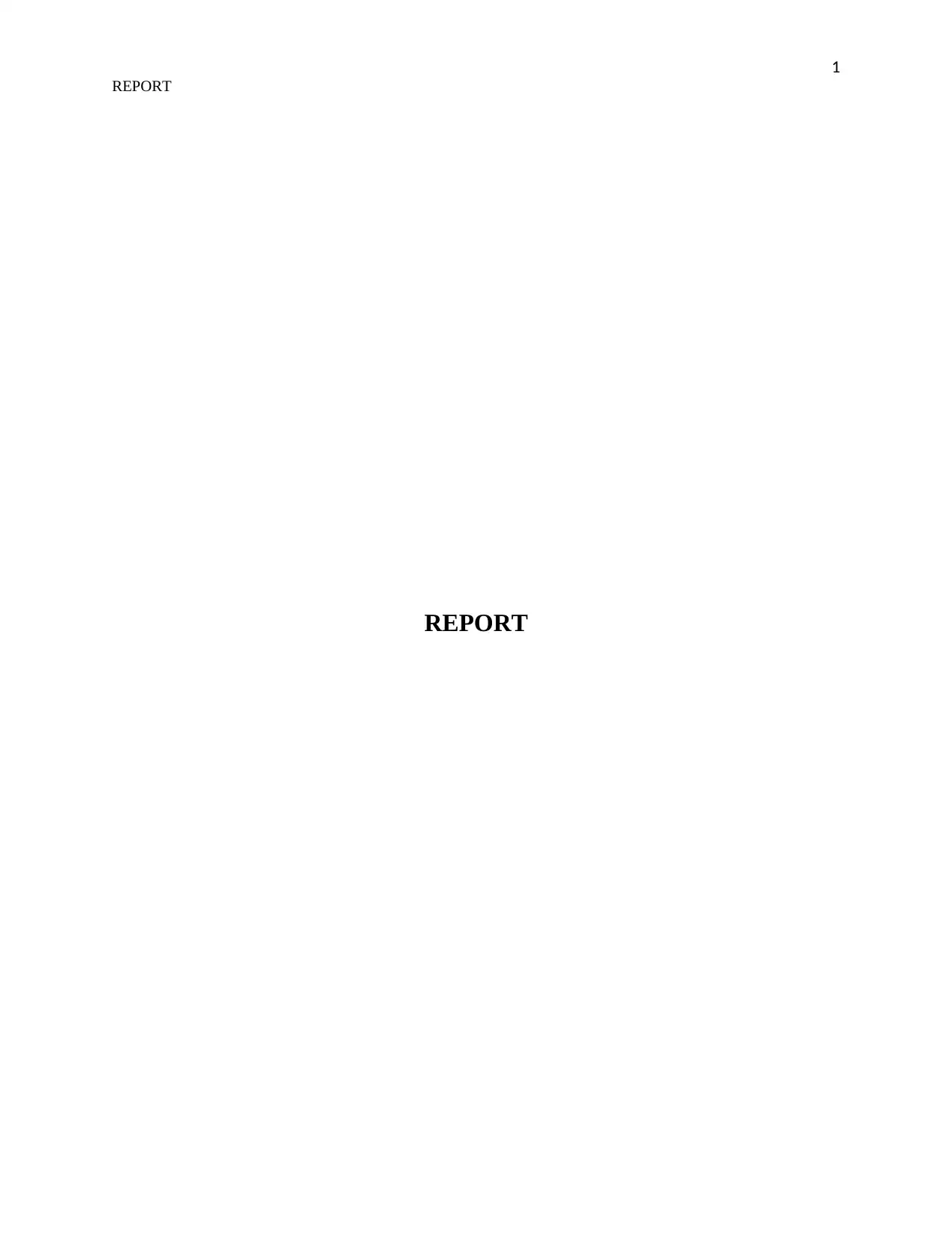
1
REPORT
REPORT
REPORT
REPORT
Paraphrase This Document
Need a fresh take? Get an instant paraphrase of this document with our AI Paraphraser
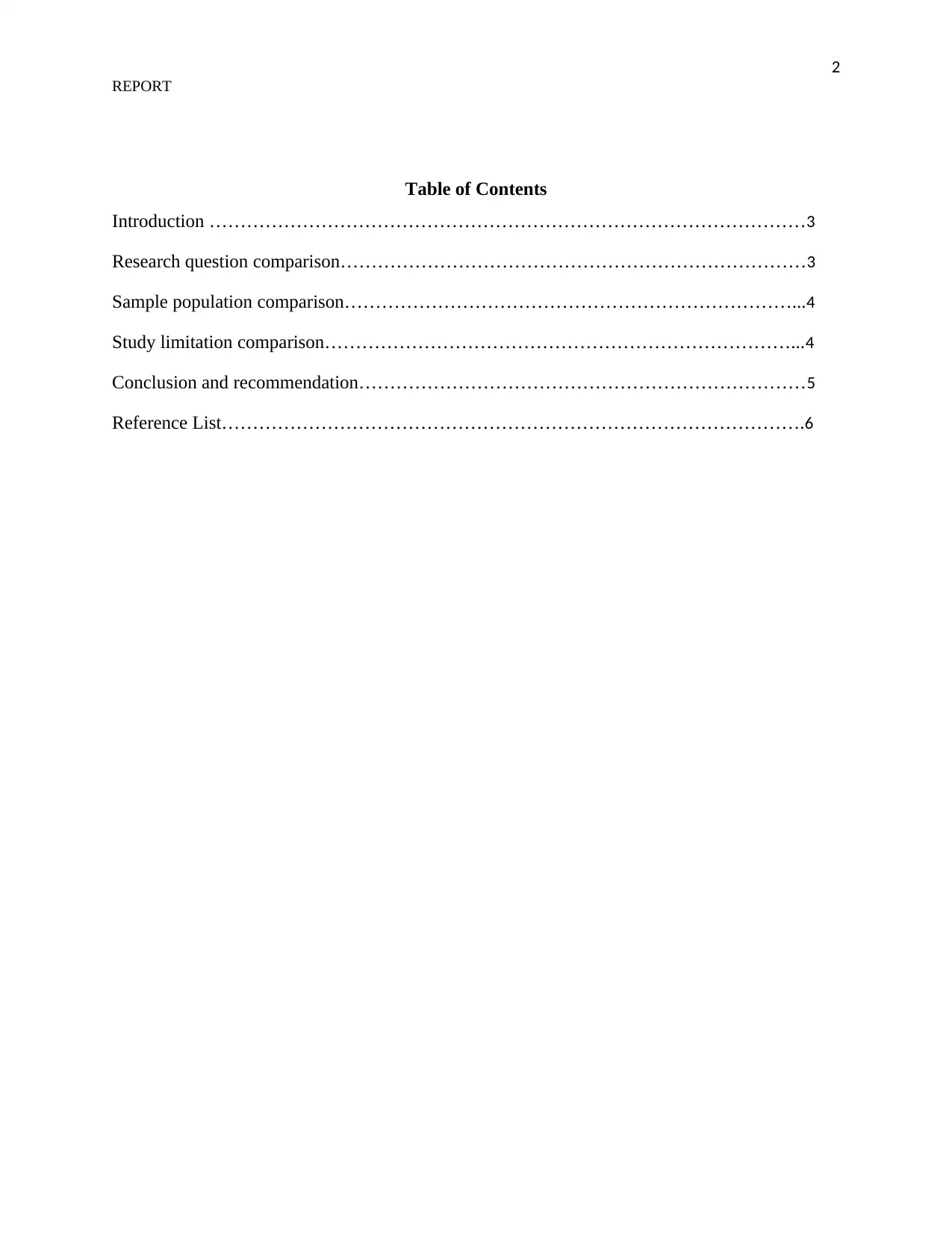
2
REPORT
Table of Contents
Introduction ……………………………………………………………………………………3
Research question comparison…………………………………………………………………3
Sample population comparison………………………………………………………………...4
Study limitation comparison…………………………………………………………………...4
Conclusion and recommendation………………………………………………………………5
Reference List………………………………………………………………………………….6
REPORT
Table of Contents
Introduction ……………………………………………………………………………………3
Research question comparison…………………………………………………………………3
Sample population comparison………………………………………………………………...4
Study limitation comparison…………………………………………………………………...4
Conclusion and recommendation………………………………………………………………5
Reference List………………………………………………………………………………….6
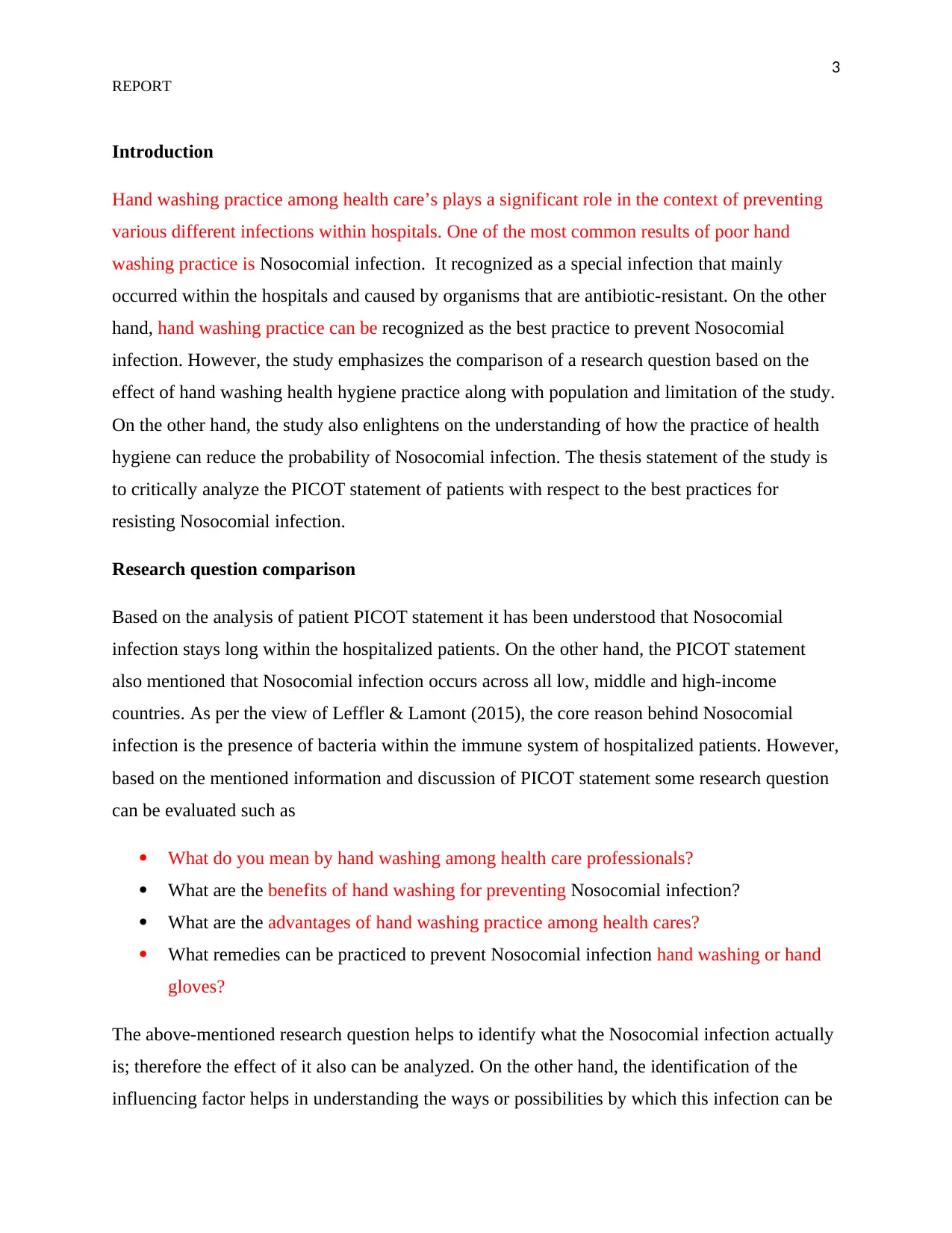
3
REPORT
Introduction
Hand washing practice among health care’s plays a significant role in the context of preventing
various different infections within hospitals. One of the most common results of poor hand
washing practice is Nosocomial infection. It recognized as a special infection that mainly
occurred within the hospitals and caused by organisms that are antibiotic-resistant. On the other
hand, hand washing practice can be recognized as the best practice to prevent Nosocomial
infection. However, the study emphasizes the comparison of a research question based on the
effect of hand washing health hygiene practice along with population and limitation of the study.
On the other hand, the study also enlightens on the understanding of how the practice of health
hygiene can reduce the probability of Nosocomial infection. The thesis statement of the study is
to critically analyze the PICOT statement of patients with respect to the best practices for
resisting Nosocomial infection.
Research question comparison
Based on the analysis of patient PICOT statement it has been understood that Nosocomial
infection stays long within the hospitalized patients. On the other hand, the PICOT statement
also mentioned that Nosocomial infection occurs across all low, middle and high-income
countries. As per the view of Leffler & Lamont (2015), the core reason behind Nosocomial
infection is the presence of bacteria within the immune system of hospitalized patients. However,
based on the mentioned information and discussion of PICOT statement some research question
can be evaluated such as
What do you mean by hand washing among health care professionals?
What are the benefits of hand washing for preventing Nosocomial infection?
What are the advantages of hand washing practice among health cares?
What remedies can be practiced to prevent Nosocomial infection hand washing or hand
gloves?
The above-mentioned research question helps to identify what the Nosocomial infection actually
is; therefore the effect of it also can be analyzed. On the other hand, the identification of the
influencing factor helps in understanding the ways or possibilities by which this infection can be
REPORT
Introduction
Hand washing practice among health care’s plays a significant role in the context of preventing
various different infections within hospitals. One of the most common results of poor hand
washing practice is Nosocomial infection. It recognized as a special infection that mainly
occurred within the hospitals and caused by organisms that are antibiotic-resistant. On the other
hand, hand washing practice can be recognized as the best practice to prevent Nosocomial
infection. However, the study emphasizes the comparison of a research question based on the
effect of hand washing health hygiene practice along with population and limitation of the study.
On the other hand, the study also enlightens on the understanding of how the practice of health
hygiene can reduce the probability of Nosocomial infection. The thesis statement of the study is
to critically analyze the PICOT statement of patients with respect to the best practices for
resisting Nosocomial infection.
Research question comparison
Based on the analysis of patient PICOT statement it has been understood that Nosocomial
infection stays long within the hospitalized patients. On the other hand, the PICOT statement
also mentioned that Nosocomial infection occurs across all low, middle and high-income
countries. As per the view of Leffler & Lamont (2015), the core reason behind Nosocomial
infection is the presence of bacteria within the immune system of hospitalized patients. However,
based on the mentioned information and discussion of PICOT statement some research question
can be evaluated such as
What do you mean by hand washing among health care professionals?
What are the benefits of hand washing for preventing Nosocomial infection?
What are the advantages of hand washing practice among health cares?
What remedies can be practiced to prevent Nosocomial infection hand washing or hand
gloves?
The above-mentioned research question helps to identify what the Nosocomial infection actually
is; therefore the effect of it also can be analyzed. On the other hand, the identification of the
influencing factor helps in understanding the ways or possibilities by which this infection can be
⊘ This is a preview!⊘
Do you want full access?
Subscribe today to unlock all pages.

Trusted by 1+ million students worldwide
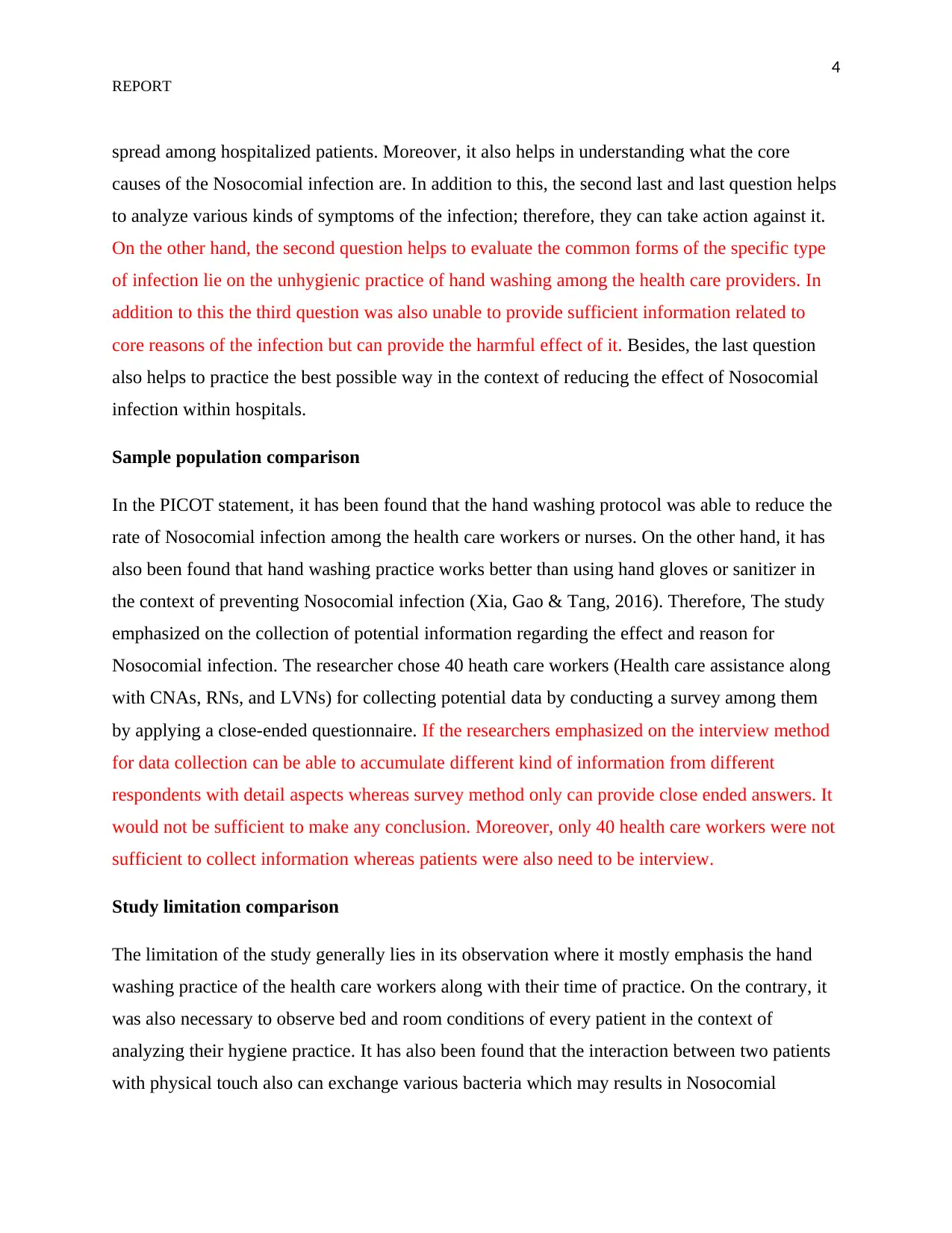
4
REPORT
spread among hospitalized patients. Moreover, it also helps in understanding what the core
causes of the Nosocomial infection are. In addition to this, the second last and last question helps
to analyze various kinds of symptoms of the infection; therefore, they can take action against it.
On the other hand, the second question helps to evaluate the common forms of the specific type
of infection lie on the unhygienic practice of hand washing among the health care providers. In
addition to this the third question was also unable to provide sufficient information related to
core reasons of the infection but can provide the harmful effect of it. Besides, the last question
also helps to practice the best possible way in the context of reducing the effect of Nosocomial
infection within hospitals.
Sample population comparison
In the PICOT statement, it has been found that the hand washing protocol was able to reduce the
rate of Nosocomial infection among the health care workers or nurses. On the other hand, it has
also been found that hand washing practice works better than using hand gloves or sanitizer in
the context of preventing Nosocomial infection (Xia, Gao & Tang, 2016). Therefore, The study
emphasized on the collection of potential information regarding the effect and reason for
Nosocomial infection. The researcher chose 40 heath care workers (Health care assistance along
with CNAs, RNs, and LVNs) for collecting potential data by conducting a survey among them
by applying a close-ended questionnaire. If the researchers emphasized on the interview method
for data collection can be able to accumulate different kind of information from different
respondents with detail aspects whereas survey method only can provide close ended answers. It
would not be sufficient to make any conclusion. Moreover, only 40 health care workers were not
sufficient to collect information whereas patients were also need to be interview.
Study limitation comparison
The limitation of the study generally lies in its observation where it mostly emphasis the hand
washing practice of the health care workers along with their time of practice. On the contrary, it
was also necessary to observe bed and room conditions of every patient in the context of
analyzing their hygiene practice. It has also been found that the interaction between two patients
with physical touch also can exchange various bacteria which may results in Nosocomial
REPORT
spread among hospitalized patients. Moreover, it also helps in understanding what the core
causes of the Nosocomial infection are. In addition to this, the second last and last question helps
to analyze various kinds of symptoms of the infection; therefore, they can take action against it.
On the other hand, the second question helps to evaluate the common forms of the specific type
of infection lie on the unhygienic practice of hand washing among the health care providers. In
addition to this the third question was also unable to provide sufficient information related to
core reasons of the infection but can provide the harmful effect of it. Besides, the last question
also helps to practice the best possible way in the context of reducing the effect of Nosocomial
infection within hospitals.
Sample population comparison
In the PICOT statement, it has been found that the hand washing protocol was able to reduce the
rate of Nosocomial infection among the health care workers or nurses. On the other hand, it has
also been found that hand washing practice works better than using hand gloves or sanitizer in
the context of preventing Nosocomial infection (Xia, Gao & Tang, 2016). Therefore, The study
emphasized on the collection of potential information regarding the effect and reason for
Nosocomial infection. The researcher chose 40 heath care workers (Health care assistance along
with CNAs, RNs, and LVNs) for collecting potential data by conducting a survey among them
by applying a close-ended questionnaire. If the researchers emphasized on the interview method
for data collection can be able to accumulate different kind of information from different
respondents with detail aspects whereas survey method only can provide close ended answers. It
would not be sufficient to make any conclusion. Moreover, only 40 health care workers were not
sufficient to collect information whereas patients were also need to be interview.
Study limitation comparison
The limitation of the study generally lies in its observation where it mostly emphasis the hand
washing practice of the health care workers along with their time of practice. On the contrary, it
was also necessary to observe bed and room conditions of every patient in the context of
analyzing their hygiene practice. It has also been found that the interaction between two patients
with physical touch also can exchange various bacteria which may results in Nosocomial
Paraphrase This Document
Need a fresh take? Get an instant paraphrase of this document with our AI Paraphraser
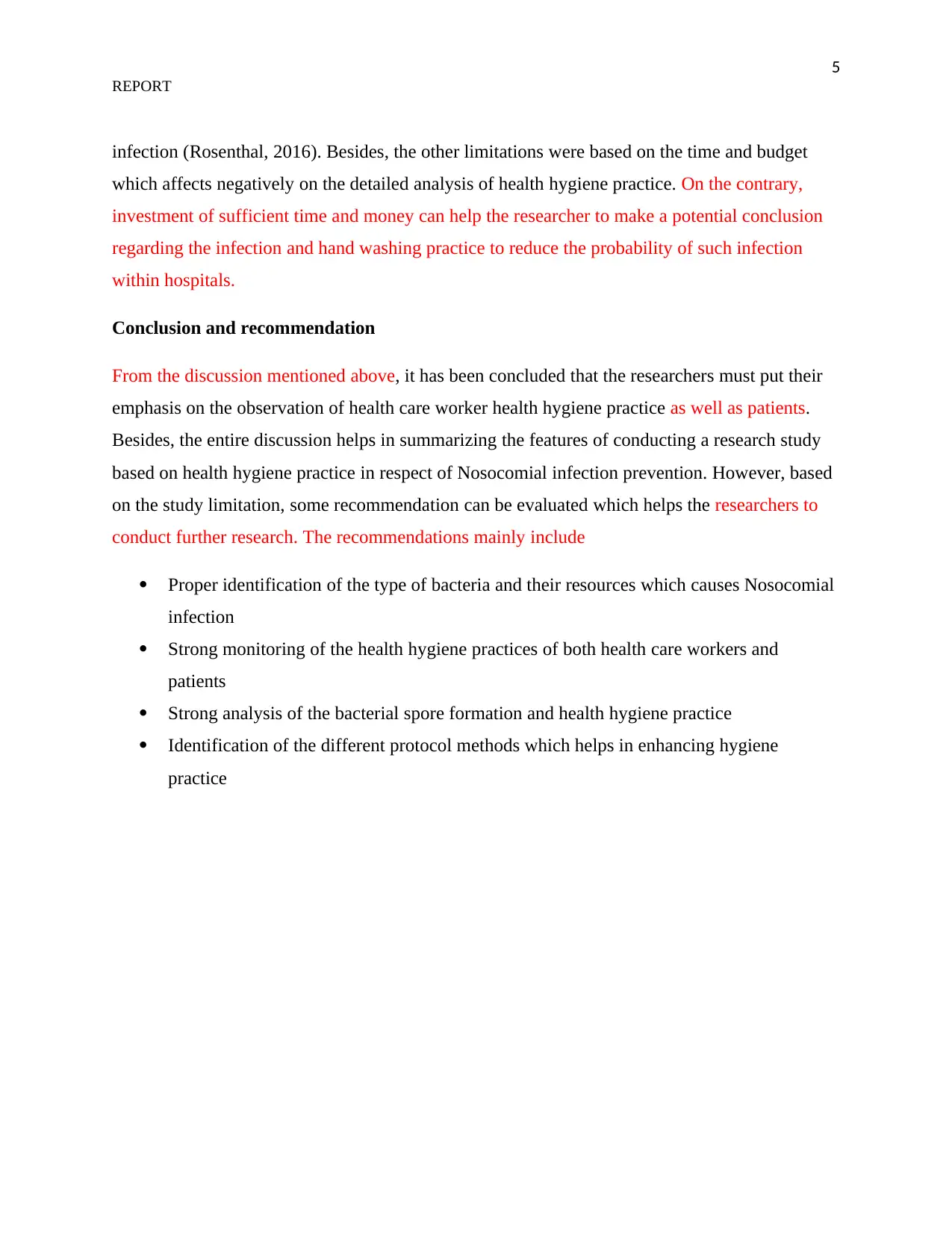
5
REPORT
infection (Rosenthal, 2016). Besides, the other limitations were based on the time and budget
which affects negatively on the detailed analysis of health hygiene practice. On the contrary,
investment of sufficient time and money can help the researcher to make a potential conclusion
regarding the infection and hand washing practice to reduce the probability of such infection
within hospitals.
Conclusion and recommendation
From the discussion mentioned above, it has been concluded that the researchers must put their
emphasis on the observation of health care worker health hygiene practice as well as patients.
Besides, the entire discussion helps in summarizing the features of conducting a research study
based on health hygiene practice in respect of Nosocomial infection prevention. However, based
on the study limitation, some recommendation can be evaluated which helps the researchers to
conduct further research. The recommendations mainly include
Proper identification of the type of bacteria and their resources which causes Nosocomial
infection
Strong monitoring of the health hygiene practices of both health care workers and
patients
Strong analysis of the bacterial spore formation and health hygiene practice
Identification of the different protocol methods which helps in enhancing hygiene
practice
REPORT
infection (Rosenthal, 2016). Besides, the other limitations were based on the time and budget
which affects negatively on the detailed analysis of health hygiene practice. On the contrary,
investment of sufficient time and money can help the researcher to make a potential conclusion
regarding the infection and hand washing practice to reduce the probability of such infection
within hospitals.
Conclusion and recommendation
From the discussion mentioned above, it has been concluded that the researchers must put their
emphasis on the observation of health care worker health hygiene practice as well as patients.
Besides, the entire discussion helps in summarizing the features of conducting a research study
based on health hygiene practice in respect of Nosocomial infection prevention. However, based
on the study limitation, some recommendation can be evaluated which helps the researchers to
conduct further research. The recommendations mainly include
Proper identification of the type of bacteria and their resources which causes Nosocomial
infection
Strong monitoring of the health hygiene practices of both health care workers and
patients
Strong analysis of the bacterial spore formation and health hygiene practice
Identification of the different protocol methods which helps in enhancing hygiene
practice
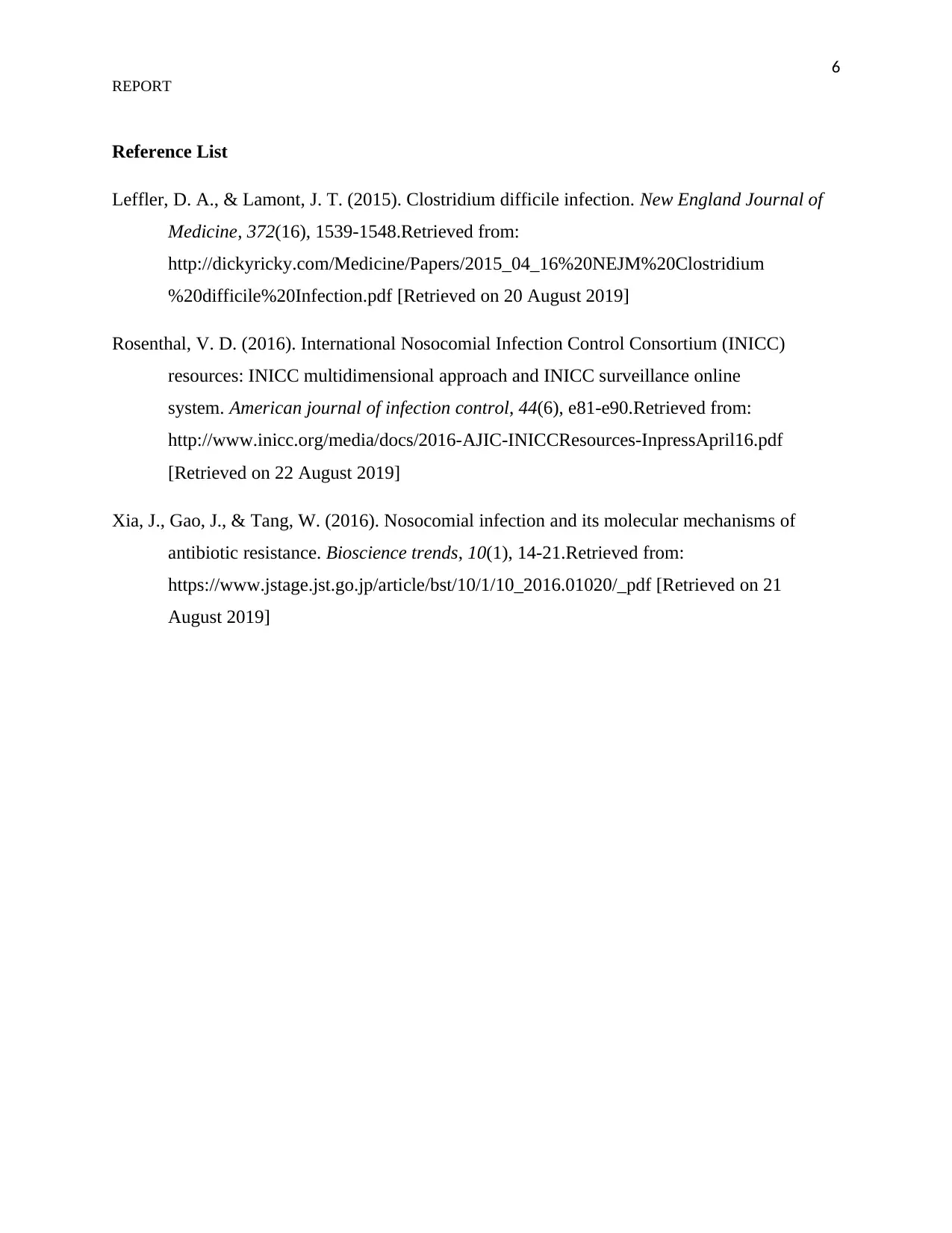
6
REPORT
Reference List
Leffler, D. A., & Lamont, J. T. (2015). Clostridium difficile infection. New England Journal of
Medicine, 372(16), 1539-1548.Retrieved from:
http://dickyricky.com/Medicine/Papers/2015_04_16%20NEJM%20Clostridium
%20difficile%20Infection.pdf [Retrieved on 20 August 2019]
Rosenthal, V. D. (2016). International Nosocomial Infection Control Consortium (INICC)
resources: INICC multidimensional approach and INICC surveillance online
system. American journal of infection control, 44(6), e81-e90.Retrieved from:
http://www.inicc.org/media/docs/2016-AJIC-INICCResources-InpressApril16.pdf
[Retrieved on 22 August 2019]
Xia, J., Gao, J., & Tang, W. (2016). Nosocomial infection and its molecular mechanisms of
antibiotic resistance. Bioscience trends, 10(1), 14-21.Retrieved from:
https://www.jstage.jst.go.jp/article/bst/10/1/10_2016.01020/_pdf [Retrieved on 21
August 2019]
REPORT
Reference List
Leffler, D. A., & Lamont, J. T. (2015). Clostridium difficile infection. New England Journal of
Medicine, 372(16), 1539-1548.Retrieved from:
http://dickyricky.com/Medicine/Papers/2015_04_16%20NEJM%20Clostridium
%20difficile%20Infection.pdf [Retrieved on 20 August 2019]
Rosenthal, V. D. (2016). International Nosocomial Infection Control Consortium (INICC)
resources: INICC multidimensional approach and INICC surveillance online
system. American journal of infection control, 44(6), e81-e90.Retrieved from:
http://www.inicc.org/media/docs/2016-AJIC-INICCResources-InpressApril16.pdf
[Retrieved on 22 August 2019]
Xia, J., Gao, J., & Tang, W. (2016). Nosocomial infection and its molecular mechanisms of
antibiotic resistance. Bioscience trends, 10(1), 14-21.Retrieved from:
https://www.jstage.jst.go.jp/article/bst/10/1/10_2016.01020/_pdf [Retrieved on 21
August 2019]
⊘ This is a preview!⊘
Do you want full access?
Subscribe today to unlock all pages.

Trusted by 1+ million students worldwide
1 out of 6
Related Documents
Your All-in-One AI-Powered Toolkit for Academic Success.
+13062052269
info@desklib.com
Available 24*7 on WhatsApp / Email
![[object Object]](/_next/static/media/star-bottom.7253800d.svg)
Unlock your academic potential
Copyright © 2020–2025 A2Z Services. All Rights Reserved. Developed and managed by ZUCOL.





